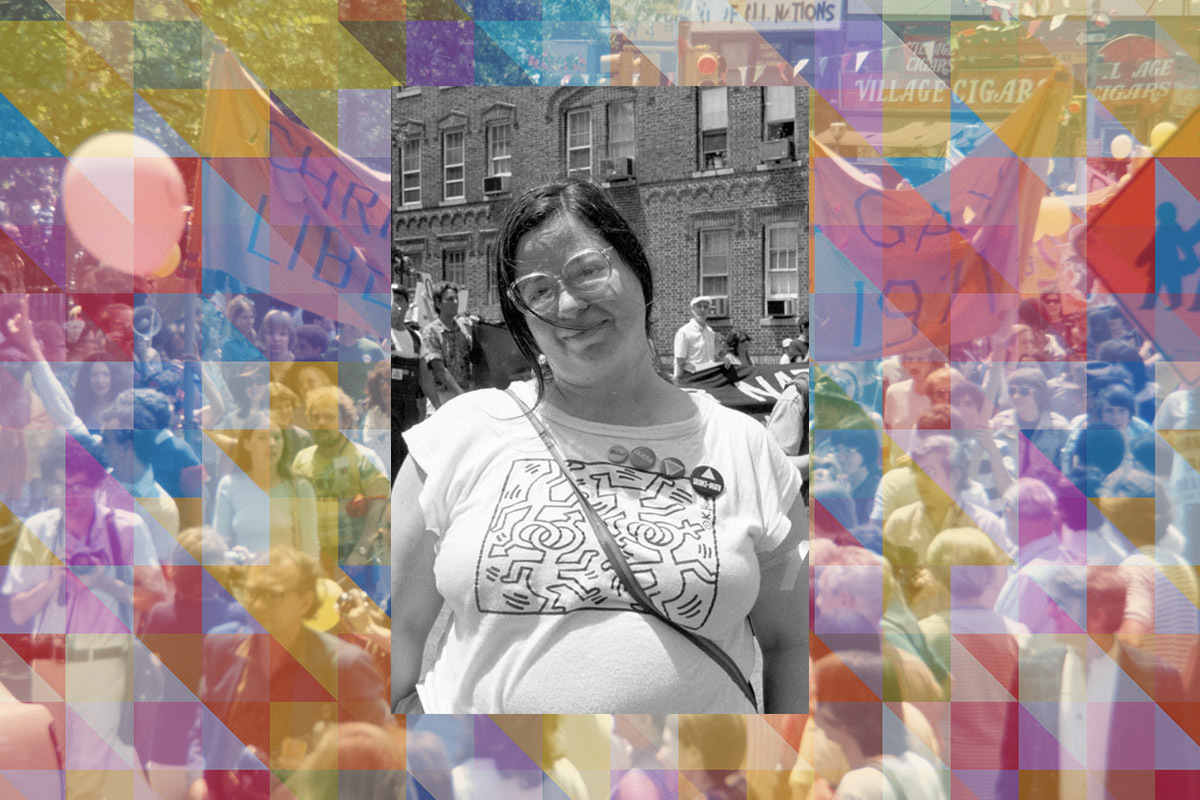Marsha P. Johnson and Sylvia Rivera — these are names you will almost certainly encounter if you are on social media during Pride Month. And rightly so! After years of historical erasure, Johnson and Rivera, two trans women of color, are finally getting the recognition they deserve for leading the 1969 Stonewall rebellion and the American gay liberation movement. Without Marsha and Sylvia, the LGBTQ+ community would not have the civil rights we do today. And in turn, Pride would not exist.
In the spirit of adding to this list of radical, queer activists everyone should know about, I humbly submit there’s another person without whom Pride would not exist: the bisexual Jewish activist Brenda Howard.
If you’ve never heard of her before this very moment, not a problem. Let’s dive in!
Who was Brenda Howard?
Brenda Howard was born in the Bronx on December 24, 1946 to a Jewish family and was given the Hebrew name Brana Bat Sirka U Shmuel Hirsh. She graduated from Syosset High School in 1964 and went on to receive a degree in nursing from Borough of Manhattan Community College in 1978.
But Brenda Howard did not go on to have a career in nursing. Instead, she went down a path of activism, participating in protests and organizing work for the anti-war movement, the feminist movement and the gay liberation movement. Later, she also demonstrated on behalf of national healthcare, people of color and those living with HIV/AIDS.
What were her most notable accomplishments?
Most notably, Howard is recognized by some as “The Mother of Pride” for playing a key role in organizing the first Gay Pride Week and The Christopher Street Liberation March of 1970. Commemorating the one-year anniversary of the Stonewall riots, The Christopher Street Liberation March was a 20-block long procession of New York’s LGBTQ+ community. It served as a very public affirmation of queer existence, survival and subversion.
As you might have already guessed, The Liberation March is now recognized as the first ever Pride parade.
But Brenda Howard didn’t stop after 1970. “You needed some kind of help organizing some type of protest or something in social justice? All you had to do was call her and she’ll just say when and where,” Howard’s partner Larry Nelson told The Advocate.
This is reflected in the fact that Howard was an active member of multiple LGBTQ+ organizations throughout her lifetime. This list includes The Gay Liberation Front, The Gay Activists Alliance, Bialogue, BiNet USA, and she even founded The New York Area Bisexual Network in 1988. On a national scale, she was a co-chair for the March on Washington for Gay and Lesbian Rights in 1987 and fought for bi-inclusion in the 1993 March on Washington for Gay, Lesbian, and Bi Equal Rights and Liberation.
How did her bisexuality play into her activism?
The sentiment bears repeating: Brenda Howard was openly and unabashedly bisexual. In a time when bi-erasure and exclusion was prevalent (or at least more so than today), Howard literally wore her bisexuality on her sleeve with a button that read, “Bi, Poly, Switch — I know what I want.” In a 2015 video for the Still Bisexual Campaign, Howard’s partner Larry Nelson emphasized that she was never confused about her sexuality and wanted bisexuals to know that they are legitimate.
After her death, BiNet USA summed up her contributions to the bisexual community, saying: “She could be difficult, she could be stubborn, she could be outrageous and she always stood up and spoke out for bisexual people and challenged biphobia even in the most hostile environments. Blessed Be.”
What was Brenda’s relationship to Judaism?
Brenda Howard found Jewish community as a member at Congregation Beit Simchat Torah in New York City, the world’s largest LGBTQ+ synagogue.
“Brenda lived a deeply Jewish life,” fellow congregant Hayyim Obadyah remembered. “She knew that for lesbian, gay, bisexual, and transgender Jews to pray together as Jews and as lesbian, gay, bisexual, and transgender people is both spiritually fulfilling and politically revolutionary. But there, as everywhere, she made sure that diversity was not just a word. She was a proud bisexual and a proud leather person. She would not let anyone take the community’s diversity for granted. Brenda cared about the Jewish community, and she made a difference in our understanding of inclusiveness.”
How has Brenda Howard been honored since her death?
Brenda Howard passed away from colon cancer on June 28, 2005, on the 36th anniversary of the Stonewall rebellion and on the 35th anniversary of the first ever Pride parade she helped to organize.
“As a knowledgeable Jew, Brenda would have readily recognized that 36 is a multiple of 18,” David Feinberg, a friend of Brenda’s from Beit Simchat Torah, wrote for her memorial. “In Jewish numerology, 18 is equivalent to the Hebrew word ‘Chai,’ which means ‘alive.’ Now if you consider that 36 is 2 times 18, and that the prefix for the number two is ‘bi,’ as in bi-coastal or bi-lateral, or, more appropriately, bi-SEXUAL, we can see very clearly that, on the mystical level of reality, Brenda lived the complete Bi life.”
After her death, the Queens chapter of Parents, Families and Friends of Lesbians and Gays (PFLAG) created the Brenda Howard Memorial Award in her honor. Every year it is awarded to a person or organization whose contributions to the bisexual and LGBTQ+ communities epitomize the work of Brenda Howard.
Additionally, Brenda Howard has been honored by Equality Forum in 2013, The Trevor Project in 2014, and was inducted to the National LGBTQ Wall of Honor in The Stonewall Inn on the 50th anniversary of the rebellion.
So, this Pride month, whether you’re celebrating by reading up on queer theory or by getting (safely) sloshed while covered in rainbow glitter, make sure to take a moment to recognize our queer elders like Marsha P. Johnson, Sylvia Rivera, and of course, Brenda Howard.
May their memories be a blessing and a queer revolution.



